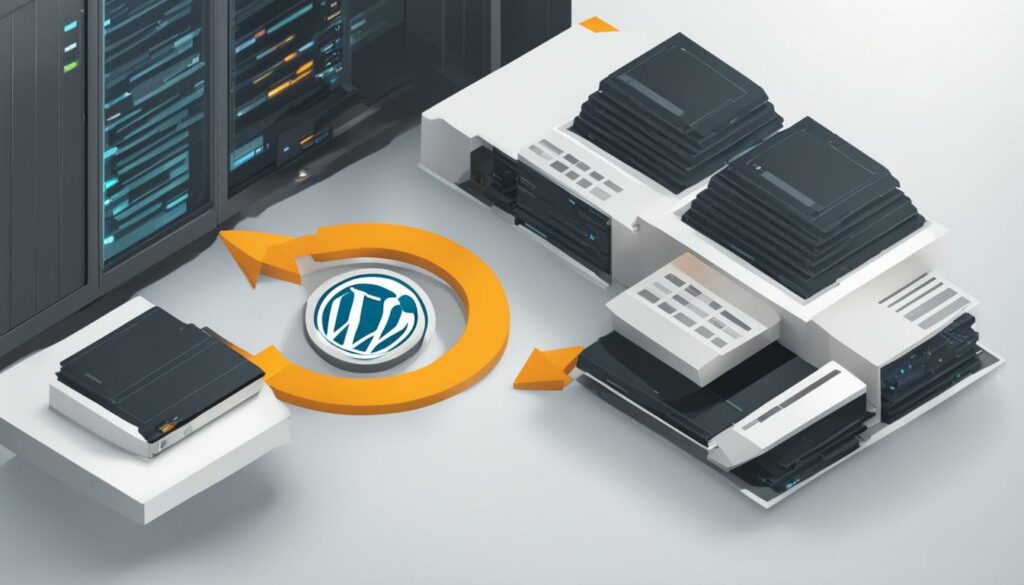Migrating your WordPress site to a new host can be a daunting task, but with the right approach and the right tools, you can ensure a smooth and successful migration process. One of the key factors in a successful migration is selecting the right WordPress theme for your site. At BoostedHost, we offer WordPress Hosting plans that provide optimal performance and can facilitate a seamless migration. With our reliable hosting and expert support, you can confidently migrate your site and enjoy a hassle-free experience.
Key Takeaways:
- Choosing the right WordPress theme is crucial for a smooth migration process.
- BoostedHost offers WordPress Hosting plans that provide optimal performance and expert support.
- Research your new host thoroughly and compare their offerings to your current provider.
- Prepare for the migration by creating a complete list of links on your site and fixing any crawl errors or broken links.
- Pick the right time for migration, inform your customers about the scheduled maintenance, and backup your website files and database.
Importance of Website Migration and Choosing a New Host
Website migration is a crucial process that involves moving your site from one host to another. This is necessary when your current hosting plan is unable to cope with the increased traffic or when you experience performance issues. Migrating to a new host can bring numerous benefits, including improved resources and a better user experience for your visitors.
Before you switch hosts, it is essential to thoroughly research your options and ensure that the new host offers a package that surpasses what your current provider offers. This will help guarantee a seamless transition and prevent any unforeseen issues from arising during the migration process.
“Migrating to a new host can bring numerous benefits, including improved resources and a better user experience for your visitors.”
When considering a new host, one of the key factors to consider is server performance. A slow-loading website can negatively impact user experience and even lead to decreased rankings in search engine results. By choosing a host with robust server performance, you can ensure that your site loads quickly and efficiently, providing an optimal experience for your visitors.
Furthermore, switching hosts gives you an opportunity to assess and optimize your website’s overall performance. You can take this chance to evaluate your website design, implement necessary updates, and enhance the functionality of your site to better meet the needs of your audience.
To summarize, website migration is a critical decision that can significantly impact the performance and success of your online presence. By choosing a new host that offers improved resources and server performance, you can ensure a seamless migration process and provide your visitors with an enhanced user experience.
| Benefits of Website Migration and Choosing a New Host | Considerations for Choosing a New Host |
|---|---|
|
|
Testimonial
“Migrating to a new host with improved server performance was a game-changer for our website. Not only did our site load faster, but we also saw a significant increase in user engagement. It’s been a smooth journey, and our visitors love the improved experience!”
– Jessica Thompson, Founder of Online Store X
Preparing for Website Migration
Before starting the migration process, it is crucial to do thorough research on your new host and compare their offerings to your current provider. This will ensure a smooth and successful transition to the new host. Take the time to evaluate their server performance, customer support, pricing plans, and other features that are important to your website’s needs.
If you are new to website migration or prefer a hassle-free experience, look for hosts that offer migration assistance. This can significantly simplify the process by guiding you through the necessary steps and handling technical aspects for you.
One essential task in preparing for migration is creating a complete list of links on your site. This can be done using tools like Screaming Frog, which crawls your website and provides a comprehensive list of URLs. By doing this, you can identify any crawl errors or broken links that need to be fixed before the migration. It is crucial to ensure that all links on your site are working correctly after the migration to avoid any negative impact on SEO.
To summarize, before you embark on the website migration journey, be sure to:
- Research and compare new hosting providers
- Consider hosts that offer migration assistance
- Create a complete list of links on your site
- Fix any crawl errors or broken links
By following these steps, you’ll be well-prepared for a successful migration and a seamless transition to your new hosting provider.
Steps to Take Before Migration
Before beginning the migration process, there are several important steps you should take to ensure a smooth and successful transition to your new hosting provider. By carefully planning and preparing for the migration, you can minimize any potential issues and ensure the safety of your website data.
Pick the Right Time
Choosing the right time to migrate your website is crucial to minimize any impact on your site’s performance. It is recommended to pick a time when your website experiences the least traffic to avoid any disruptions to your visitors.
Clear Your Schedule
To ensure a successful migration, it’s essential to clear your schedule and avoid making any changes to your website during the migration process. Pausing content creation and updates will prevent you from losing any modifications or data during the transfer.
Inform Your Customers
Keep your customers informed about the scheduled maintenance and the temporary unavailability of your website during the migration process. By notifying them in advance, you can manage their expectations and minimize any inconvenience caused.
Set Up a New Hosting Account
Before migrating, you need to set up a new hosting account with your chosen provider. Take the time to explore the features and capabilities of the new host to ensure it meets your website’s requirements and provides a better hosting environment.
Backup Your Website
Creating a backup of your website is crucial to ensure the safety of your data. Before initiating the migration process, make sure to back up all your website files and databases. This will serve as a safety net in case any issues arise during the migration.
Summary:
| Steps | Description |
|---|---|
| Pick the Right Time | Choose a time with minimal traffic to migrate your website. |
| Clear Your Schedule | Pause content creation and updates to avoid losing any modifications. |
| Inform Your Customers | Notify your customers of the scheduled maintenance and temporary unavailability of your website. |
| Set Up a New Hosting Account | Create a new hosting account with your chosen provider and explore its features. |
| Backup Your Website | Create a backup of your website files and databases. |
By following these steps, you can prepare yourself and your website for a successful migration. Taking the time to pick the right time, clear your schedule, inform your customers, set up a new hosting account, and backup your website will help ensure a smooth transition to your new hosting provider.
Step-by-Step Guide to Migrating Your Site
When it comes to migrating your site to a new host, following a step-by-step guide can make the process much smoother. In this section, we’ll walk you through the essential steps to migrate your site successfully.
1. Put your site in maintenance mode
To prevent any changes or updates during the migration process, it’s crucial to put your site in maintenance mode. This ensures that your site remains intact and avoids any inconsistencies that could occur due to ongoing activities.
“Putting your site in maintenance mode ensures a seamless migration without any interruptions.”
2. Migrate your site files and databases
Next, you’ll need to migrate your site files and databases to the new host. This involves uploading all your site files to the new host’s server and transferring your database. Additionally, you’ll need to update the wp-config.php file to connect to the new database.
“Migrating your site files and databases ensures that all your content and data are transferred to the new host.”
3. Direct your domain to the new host
Once your site files and databases are migrated, the next step is to direct your domain to the new host. This involves updating the DNS records to point your domain name to the new server where your site is hosted. Keep in mind that it may take up to 72 hours for the changes to propagate worldwide.
“Directing your domain to the new host ensures that visitors can access your site on the new server.”
By following these steps, you’ll be able to migrate your site smoothly to a new host, ensuring minimal downtime and a seamless transition for your visitors.

In the next section, we’ll explore the importance of post-migration checks and testing to ensure that your site is fully functional and optimized for performance.
Post-Migration Checks and Testing
After successfully migrating your WordPress site to a new host, it’s crucial to perform comprehensive checks and testing to ensure that everything is functioning as intended. By conducting front-end and back-end checks, site performance testing, and verifying site indexing, you can ensure a smooth transition and maintain the visibility of your website.
Front-End and Back-End Checks
First, it’s essential to test both the front-end and back-end of your website. On the front-end, check for any broken links, missing images, or formatting issues that may have occurred during the migration process. Make sure that all pages, posts, and media files are accessible and display correctly.
On the back-end, test the functionality of your site’s admin panel, ensuring that you can add, update, and delete content without any errors. Verify that all plugins and themes are functioning properly and are compatible with the new host. Test any custom functionalities or integrations to ensure they are working as expected.
Site Performance Testing
Site performance plays a significant role in user experience and search engine rankings. Therefore, it’s crucial to assess your site’s performance after the migration. Use tools like GTmetrix to analyze your site’s load times, page speed, and overall performance. Identify any areas for improvement and optimize your site accordingly.
Pay attention to factors such as caching, image optimization, minification of CSS and JS files, and server response time. By addressing these performance issues, you can enhance the user experience and potentially improve your site’s search engine visibility.
Site Indexing
Once your site is up and running on the new host, it’s important to ensure that search engines can index your pages and display them in search results. To verify site indexing, perform a site:yourdomain.com search on search engines like Google. This will display a list of indexed pages from your site.
If you notice any discrepancies or if some pages are missing, submit an updated sitemap to search engines. This helps search engine crawlers discover all your pages and helps improve your site’s visibility in search results.
By conducting thorough post-migration checks and testing, you can confidently ensure that your site is functioning correctly on the new host. Address any issues that arise promptly to provide a seamless user experience and maintain your site’s visibility in search engine rankings.
Reasons for WordPress Site Migration
There are various reasons why you may consider migrating your WordPress site. Let’s explore some of the most common scenarios:
Swapping Hosting Providers
If you’re experiencing performance issues with your current hosting provider or encountering a lack of technical support, it may be time to consider swapping hosting providers. A reliable and efficient hosting provider is essential for the smooth operation of your WordPress site, ensuring optimal performance, security, and uptime.
“Migrating to a new hosting provider can solve performance issues and offer better support for a seamless online experience.”
Moving to a WordPress Multisite Network
If you have multiple WordPress sites or are planning to expand your online presence, moving to a WordPress Multisite network can simplify management and reduce administrative overhead. With a Multisite network, you can centrally manage multiple WordPress sites from a single dashboard, making it easier to update plugins, themes, and core files.
“A WordPress Multisite network offers streamlined management of multiple sites from a single dashboard.”
Changing Domain Name
Rebranding, refocusing your target audience, or wanting a more memorable domain name are common reasons for changing your WordPress site’s domain name. This process involves updating your website’s URL and ensuring a smooth transition to maintain search engine rankings and user accessibility.
“Changing your domain name requires careful planning and execution to prevent any disruptions to your site’s visibility and user experience.”
Reasons for WordPress Site Migration
| Reasons | Description |
|---|---|
| Swapping Hosting Providers | Performance issues or lack of support from the current host |
| Moving to a WordPress Multisite Network | Centralized management of multiple WordPress sites |
| Changing Domain Name | Rebranding or targeting a new audience |

Whether you’re swapping hosting providers, moving to a WordPress Multisite network, or changing your domain name, a successful migration requires careful planning and execution. By considering your specific needs and following the appropriate steps, you can ensure a smooth transition and take advantage of the benefits that come with a well-executed WordPress site migration.
Manual Migration Process and WordPress Plugins
While there are numerous WordPress migration tools available, it’s crucial to understand how to manually migrate a WordPress site, especially when dealing with larger websites or transfers between hosting companies. The manual migration process, although more complex, provides greater control over the migration and allows for a customized approach.
Back up Site Files and Export the Database
Before moving your WordPress site, it’s essential to back up all your site files and export the database. This ensures that you have a copy of your site’s data that can be easily transferred to the new host. Use FTP file transfer tools like FileZilla to download all the files from your current server, and export the database using phpMyAdmin or a similar database management tool.
Create a New WordPress Installation on the New Host
Next, you’ll need to create a new WordPress installation on the new host. This involves setting up a new database and a new MySQL user with secure credentials. Most hosting providers offer cPanel or a similar control panel, where you can easily create a new database and user.
Upload Files and Import the Database
After creating a new WordPress installation, use FTP file transfer tools to upload the site files to the new host. Ensure that you maintain the same file structure and directory hierarchy. Once the files are uploaded, import the database you exported earlier into the new database you created. This can be done using phpMyAdmin or a similar tool provided by your hosting provider.
Adjust wp-config.php File
Once the files and database are in place, you’ll need to adjust the wp-config.php file. This file contains the configuration settings for your WordPress site. Open the wp-config.php file in a text editor and update the database connection details to match the new host, including the database name, MySQL username, and password. Save the file once the changes are made.
Perform Post-Migration Cleanup
Finally, after completing the migration, it’s essential to perform post-migration cleanup tasks. Update any hardcoded links in your site content to reflect the new domain name or URLs. Additionally, check for any broken links or missing images that may have occurred during the migration process.
To make the migration process more efficient and streamline certain tasks, there are several WordPress plugins available. These plugins automate specific aspects of the migration, such as exporting and importing the database and transferring files via FTP. Some popular WordPress migration plugins include:
- Duplicator: This plugin allows you to create a complete backup of your site and easily move it to a new host.
- All-in-One WP Migration: With this plugin, you can export your entire WordPress site, including the database, media files, plugins, and themes, and import it into a new installation.
- UpdraftPlus: This plugin provides a comprehensive backup solution, allowing you to store your site’s files and databases in the cloud or download them to your local machine.
Using these plugins can save time and simplify the migration process, particularly for users who are not comfortable with manual migrations or have limited technical expertise.
| WordPress Migration Tools | Features |
|---|---|
| Duplicator | Provides complete site backups and simplifies migration with easy-to-follow steps. |
| All-in-One WP Migration | Enables seamless export and import of entire WordPress sites, including themes, plugins, and media files. |
| UpdraftPlus | Offers comprehensive backup options, including storing files in the cloud and automatic backups. |
Using a combination of manual migration techniques and WordPress migration plugins can help simplify the process and ensure a successful transfer of your WordPress site to a new host. However, it’s important to always perform thorough backups and test your site after migration to identify and fix any issues that may arise.
Importance of Backing Up Your Website
Before migrating your WordPress site, it is crucial to prioritize the security of your site’s data. Backing up your website ensures that you have a copy of all your important files and information, minimizing the risk of data loss during the migration process. Utilizing website backup plugins and manual backup processes are effective methods to safeguard your data.
Website Backup Plugins
One option for backing up your WordPress site is to use website backup plugins. These plugins, such as Duplicator and UpdraftPlus, offer comprehensive backup features that allow you to easily and securely create backups of your website files, database, and other critical data.
“Website backup plugins like Duplicator and UpdraftPlus offer an effortless way to create backups of your WordPress site, ensuring that your data is safe and accessible.”
Manual Backup Process
If you prefer a more hands-on approach, you can perform a manual backup process using file transfer tools like FTP programs. This process involves downloading your website files and exporting your database, ensuring that you have a complete backup of your site’s data.
“Performing a manual backup using FTP programs allows for complete control over the backup process, giving you peace of mind knowing that your data is protected.”
To perform a manual backup, follow these steps:
- Using an FTP program, connect to your website’s server.
- Navigate to the root folder of your WordPress site.
- Download all the files and folders from the root directory to your local computer.
- Access your website’s database through a tool like phpMyAdmin.
- Export the database as an SQL file.
By backing up your website using website backup plugins or performing a manual backup, you can ensure the safety of your data and have peace of mind during the migration process.
| Method | Pros | Cons |
|---|---|---|
| Website Backup Plugins |
|
|
| Manual Backup Process |
|
|

Creating a New WordPress Installation on the New Host
To migrate your WordPress site to a new host, you need to create a new WordPress installation on the new host. This involves creating a new database and a new MySQL user with secure credentials through cPanel or the hosting provider’s database management tool. These steps are essential for setting up the environment for the migration process.
Steps to Create a New WordPress Installation:
- Access your hosting account’s cPanel.
- Locate the “Databases” section and click on “MySQL Databases”.
- Create a new database by entering a name for the database and clicking “Create Database”.
- Next, create a new MySQL user by entering a username and password, and clicking “Create User”.
- Associate the new user with the database by scrolling down to the “Add User to Database” section. Select the user and database from the respective dropdown menus, then click “Add”.
- In the “Manage User Privileges” section, grant the user all privileges by selecting the “All Privileges” checkbox and clicking “Make Changes”.
Once you have completed these steps, you have successfully created a new WordPress installation on your new host. You can now proceed with transferring your website files and databases to the new host.
Important Note:
Make sure to keep a record of the database name, username, and password. You will need this information during the migration process.
Conclusion
In conclusion, migrating your WordPress site to a new host can be a complex process, but with proper planning and execution, it can be a smooth and successful transition. When embarking on a WordPress site migration, one of the crucial considerations is choosing the right host. Selecting a reliable and reputable hosting provider ensures that your site will be supported by optimal resources and performance.
Before initiating the migration process, it is essential to back up your site data to prevent data loss during the transfer. By creating a backup of your website files and database, you can safeguard your valuable content and ensure a secure and seamless migration.
After the migration, thorough testing is crucial to ensure that your site is functioning as expected. Conduct front-end and back-end checks to confirm that all functionalities are working properly. Additionally, use performance testing tools to optimize your site’s speed and ensure an optimal user experience.
By following the step-by-step guide and considering the factors mentioned in this article, you can confidently migrate your WordPress site, choosing the right host, backing up your data, and testing your site thoroughly. With careful planning and attention to detail, you can enjoy a successful migration and the benefits of your new hosting provider.
FAQ
Q: What is website migration?
A: Website migration is the process of moving a site from one host to another.
Q: Why would I need to migrate my WordPress site to a new host?
A: You may need to migrate your WordPress site to a new host if your current hosting plan is unable to handle the increased traffic or if you are experiencing performance issues.
Q: What should I consider when selecting a new host for my WordPress site?
A: It is important to research and compare the offerings of different hosts and ensure that the new host provides a better package and support than your current provider.
Q: How can I prepare for a website migration?
A: Before migration, research your new host, create a complete list of links on your site, and ensure any crawl errors or broken links are fixed.
Q: What steps should I take before starting the migration process?
A: Choose the right time for migration, inform your customers about scheduled maintenance, pause content creation, set up your new hosting account, and create a backup of your website files and database.
Q: What are the steps involved in migrating my WordPress site?
A: Put your site in maintenance mode, migrate site files and databases, and direct your domain to the new host.
Q: What post-migration checks should I perform?
A: Test the front-end and back-end of your site, check site performance and page load times, and ensure that your site is being indexed by search engines.
Q: Why do people choose to migrate their WordPress sites?
A: People often migrate their WordPress sites to swap hosting providers, move to a WordPress Multisite network, or change their domain name.
Q: What is the manual migration process for WordPress sites?
A: The manual migration process involves backing up your site data, creating a new WordPress installation on the new host, and adjusting settings and files accordingly.
Q: How important is backing up my website before migration?
A: It is crucial to back up all your site data to ensure data security and prevent loss during the migration process.
Q: How do I create a new WordPress installation on the new host?
A: To create a new WordPress installation, you need to set up a new database and a new MySQL user with secure credentials.












